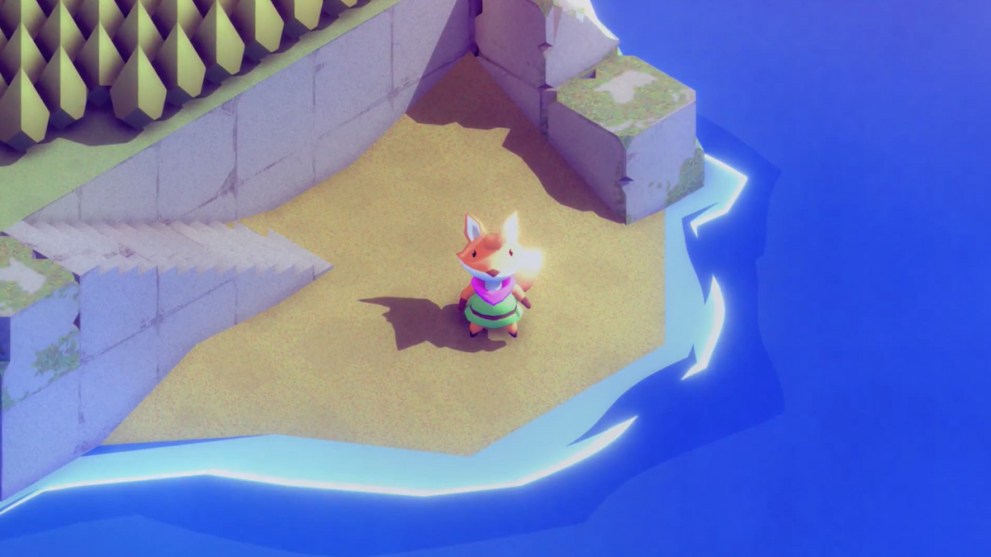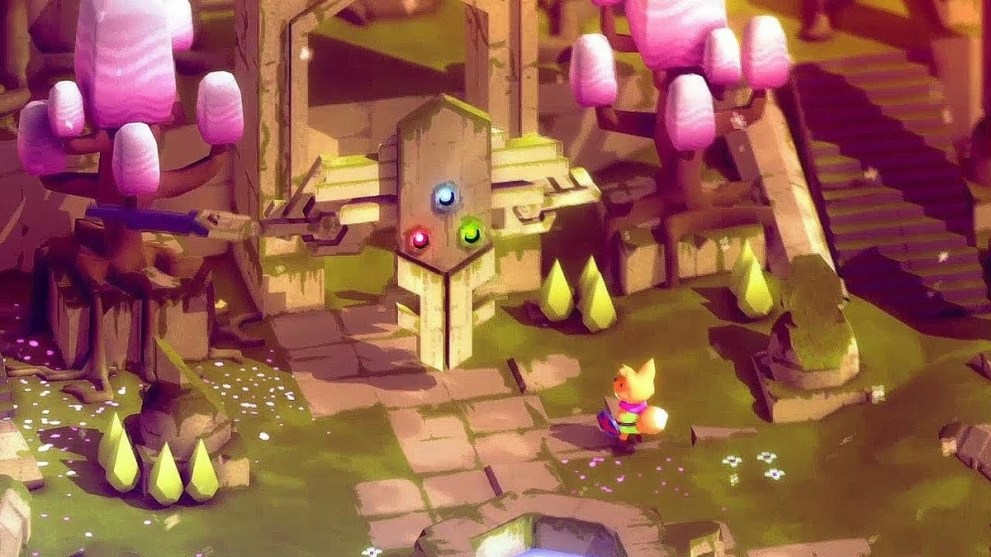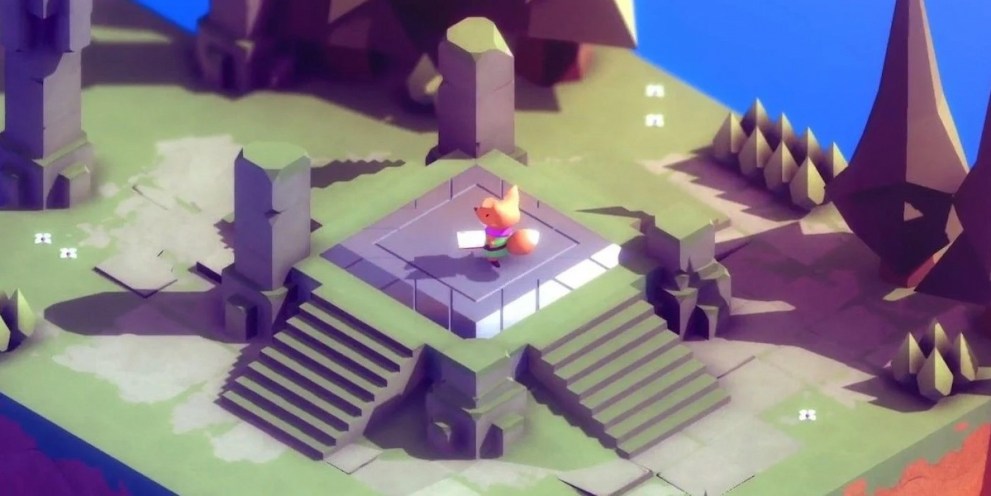Tunic on PC
Tunic is an ode to old-school instruction manuals. I know, that’s not the most riveting idea on paper, but give it just a couple of hours and it’ll win you over with its exceptional mechanics and ingenuity. Developer Andrew Shouldice isn’t shy of making his inspirations blindingly obvious — the green tunic-clad fox is a little on-the-nose, after all — but rather than simply emulating these icons of the video game medium, he molds them into something new, and something rather special.
This is going to sound like a big ol’ cop-out coming from someone reviewing the game, but Tunic is best enjoyed going in knowing as little as possible. That’s because the game doesn’t hold your hand, push waypoints on your screen or giving you a quest list. It doesn’t signpost where you should be going or how exactly you’re supposed to navigate an area teeming with an HP-draining purple mist. From the very beginning, you’re left to piece things together, acquiring pages of an old-school style instruction manual that will very vaguely hint at what you’re supposed to do, and leave you to figure out the rest.
Things start off with the titular fox protagonist awakening on a beach, with nothing but his rather familiar-looking green tunic to his name. Soon, he finds a stick, and a bit of an instruction manual. An alien text is scrawled across most of the first pages you acquire, and so you’re left with but a few readable words and some diagrams to figure out your next steps.
The more you explore, the more you’ll learn about the world and why you’re doing what you’re doing. But the air of mystery never wears off, and the fantastical sense you get from exploring the world is only heightened by a frankly spectacular soundtrack from Lifeformed — Terrence Lee and Janice Kwan — that punctuates boss battles with emphatic piano scores and quieter moments of exploring the world with chill synth beats. It nails the atmosphere with every new area you explore or enemy you encounter.

In a sense, Tunic is just as much of a puzzle game as it is an action-adventure title. By drip-feeding you these cryptic clues, giving you random pages from the instruction manual in an order that makes sense with your progress — though not in numerical order — you’ll constantly be referring back to it, flicking back and forth to connect the dots between clues or maps sprawled across different pages. You’ll be making your own jottings to revisit a certain area to try and figure out what that strange object is, or how you reach that seemingly unreachable treasure chest.
Flicking through a digital handbook may sound a little dull, but Shouldice has painstakingly designed this, with excellent diagrams, and littered it with clues and secrets that you won’t actually realize until hours later. It’s simply captivating, and the more you play, the more Tunic’s mysteries become even more compelling. There’s far more to Tunic than meets the eye.
It’s not just the instruction manual that’s been intricately designed, though. Tunic’s world is just as enigmatic, with random objects begging to be interacted with, but with no clear instructions as to how. Treasure chests are hidden behind corners, secret paths are tucked away out of sight of the perspective the camera angle gives you, and what initially seemed like some fancy aesthetic touches turn out to be far more.
Tunic doesn’t hold your hand, but that’s what makes the game such a joy to play. There’s an overwhelming sense of satisfaction when you figure something out, though, admittedly, there were a few times I just didn’t know what I was supposed to be doing next. It resulted in me exploring for hours on end, reluctant to engage with the reviewer’s Discord the publisher had set up, determined to figure things out on my own. In the end, I conceded defeat, and after asking a peer or two, was quickly back on my way.
That’s no secret by the way. Publisher Finji wants it to be known that community collaboration is key when playing Tunic. It expects you to get stuck, and wants to reignite the days of watercooler or playground conversations, discussing secrets in the world, tips for beating that boss, or just where you’re supposed to go next. It’s admirable, and I had a blast discussing things with my peers, but in a world where the internet is such a dominant part of our daily lives and guides can give you the exact answer you’re looking for with the help of a quick Google, I think this will get lost in the transition to a larger, mass audience.
Guides and walkthroughs will likely help alleviate some of the frustrations that can arise from Tunic’s obscure clues, which is arguably my biggest grievance. Yes, the answers were ‘in front of me all along,’ but they’re so easy to overlook that what should only take you a couple of minutes to do can stretch into hours long sessions of banging your head against the same shiny silver monolith over and over again.

It’s not just the puzzling that’s both brilliant and also frustrating, though. While Tunic might look all cute and cuddly on the surface, it doesn’t hold any punches when it comes to its combat. The boss battles, in particular, will really test your mettle, forcing you to learn attack patterns, and will punish you if you get too greedy with getting a few hits in before retreating to safety. The stamina gauge will deplete with every dodge roll, but deplete it too much and you’ll take more damage if you do take a hit.
What unfolds is a combat system not too dissimilar to that of last year’s excellent Death’s Door. It rewards a thoughtful and methodical approach, rather than spamming your attacks with reckless abandon. A deadly dance is likely to ensue, and you’ll probably die quite a bit, but you’re immediately thrown back into the action and each attempt will get you one step closer to cracking the code.
Even the normal enemies you find patrolling the world are varied, not just in the looks but in their attack patterns. Giant spider-like enemies retreat back when faced, before lunging at you when they’re backed into a corner or see your guard has dropped, while aggressive foot soldier enemies charge at you, swinging their swords wildly. Other crocodile-like enemies can quickly overwhelm and chomp away at your HP, especially in a group, but can’t turn very well, providing you an opportunity to exploit their weakness and avoid their deadly jaws.
The combat can get a little frustrating at times, too, largely because the lock-on system can be a bit finicky. It’ll lock-on to an enemy (or object in the world) that doesn’t really make sense in the scenario, forgoing the enemy sprinting towards you head-on, often resulting in you taking needless damage. It was only halfway through my time with Tunic I discovered you can actually change your lock-on target with a flick of the right analog stick, but nowhere in the in-game instruction manual or even in the controller layout within the Options menu does it state that this could be done.
Given how many attempts some boss battles can take, the fact the game doesn’t replenish your consumable items you used immediately before dying aren’t replenished upon respawning can add to the frustration. These can be bought from a spooky skeleton spirit merchant with the crystal-like currency, but this is also used for leveling up your stats, or buying more important, permanent buffs for your character.
It’s not a dealbreaker, but a word of warning prior to me spamming all of my bombs on a particularly tough boss fight would have saved me a chunk of time having to grind out currency and traipsing over to the merchant to replenish my stock, and I imagine I won’t be the only one that will be caught out by this.
But no matter how frustrated I got at my foolish approach to a boss battle, or for having overlooked a clue that was staring me in the face for hours, Tunic kept me coming back. I can also see its ambiguity simply not resonating with players, in very much the same way that the Soulsborne series isn’t for everyone. That’s not a direct comparison, for what it’s worth, as Tunic does tell you the answer if you’re eagle-eyed enough to spot the clue and able to decipher it. Just know that this isn’t the cute, cuddly and straightforward experience its appearance may suggest.

There’s so much more I wish I could talk about here, as it’s where Tunic’s true ingenuity stands out, but doing so would spoil the surprise (and I’m not allowed to), so all I’ll say is that Tunic constantly throws curveballs at you, and just when you think you’ve figured everything out, you’re probably only just scratching the surface of the mysteries of this fascinating world.
Every once in a while, a true indie gem comes along. A classic for the ages lauded by critics and players alike. One inspired by classics, taking their best mechanics before refining and crafting something wholly unique and simply unforgettable, for better and occasionally, for worse. After more than 15 hours of deciphering cryptic clues and losing myself in its meticulously-crafted, mysterious world, Tunic has cemented itself in that bracket of all-time indie classics, and one that you simply have to play.
- Mysterious world that just keeps on giving.
- Challenging and compelling gameplay.
- Secrets... secrets everywhere!
- Exceptional soundtrack.
- Charming art style, but don't let it lull you into a false sense of security.
- Vague clues can sometimes lead to hours of aimless wandering.
- Lock-on can be finicky and frustrating in particularly hectic combat scenarios.













Updated: Mar 15, 2022 06:27 am